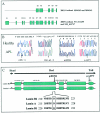Sequencing of the reannotated LMNB2 gene reveals novel mutations in patients with acquired partial lipodystrophy
- PMID: 16826530
- PMCID: PMC1559499
- DOI: 10.1086/505885
Sequencing of the reannotated LMNB2 gene reveals novel mutations in patients with acquired partial lipodystrophy
Abstract
The etiology of acquired partial lipodystrophy (APL, also called "Barraquer-Simons syndrome") is unknown. Genomic DNA mutations affecting the nuclear lamina protein lamin A cause inherited partial lipodystrophy but are not found in patients with APL. Because it also encodes a nuclear lamina protein (lamin B2) and its genomic structure was recently reannotated, we sequenced LMNB2 as a candidate gene in nine white patients with APL. In four patients, we found three new rare mutations in LMNB2: intron 1 -6G-->T, exon 5 c.643G-->A (p.R215Q; in two patients), and exon 8 c.1218G-->A (p.A407T). The combined frequency of these mutations was 0.222 in the patients with APL, compared with 0.0018 in a multiethnic control sample of 1,100 subjects (P = 2.1 x 10-7) and 0.0045 in a sample of 330 white controls (P = 1.2 x 10-5). These novel heterozygous mutations are the first reported for LMNB2, are the first reported among patients with APL, and indicate how sequencing of a reannotated candidate gene can reveal new disease-associated mutations.
Figures

Similar articles
-
A Rare Mutation in LMNB2 Associated with Lipodystrophy Drives Premature Cell Senescence.Cells. 2021 Dec 24;11(1):50. doi: 10.3390/cells11010050. Cells. 2021. PMID: 35011612 Free PMC article.
-
A Chinese patient with acquired partial lipodystrophy caused by a novel mutation with LMNB2 gene.J Pediatr Endocrinol Metab. 2012;25(3-4):375-7. doi: 10.1515/jpem-2012-0007. J Pediatr Endocrinol Metab. 2012. PMID: 22768673
-
Barraquer-Simons syndrome: a rare clinical entity.Am J Med Genet A. 2014 Jul;164A(7):1756-60. doi: 10.1002/ajmg.a.36491. Epub 2014 May 1. Am J Med Genet A. 2014. PMID: 24788242
-
Nuclear envelope-related lipodystrophies.Semin Cell Dev Biol. 2014 May;29:148-57. doi: 10.1016/j.semcdb.2013.12.015. Epub 2013 Dec 30. Semin Cell Dev Biol. 2014. PMID: 24384368 Review.
-
Laminopathies and lamin-associated signaling pathways.J Cell Biochem. 2011 Apr;112(4):979-92. doi: 10.1002/jcb.22992. J Cell Biochem. 2011. PMID: 21400569 Review.
Cited by
-
Hippocampal LMNA Gene Expression is Increased in Late-Stage Alzheimer's Disease.Int J Mol Sci. 2019 Feb 18;20(4):878. doi: 10.3390/ijms20040878. Int J Mol Sci. 2019. PMID: 30781626 Free PMC article.
-
Beyond membrane channelopathies: alternative mechanisms underlying complex human disease.Acta Pharmacol Sin. 2011 Jun;32(6):798-804. doi: 10.1038/aps.2011.34. Acta Pharmacol Sin. 2011. PMID: 21642948 Free PMC article. Review.
-
Lamin A/C Mechanotransduction in Laminopathies.Cells. 2020 May 24;9(5):1306. doi: 10.3390/cells9051306. Cells. 2020. PMID: 32456328 Free PMC article. Review.
-
LINCing lamin B2 to neuronal migration: growing evidence for cell-specific roles of B-type lamins.Nucleus. 2010 Sep-Oct;1(5):407-11. doi: 10.4161/nucl.1.5.12830. Nucleus. 2010. PMID: 21278813 Free PMC article.
-
Diseases of the nuclear envelope.Cold Spring Harb Perspect Biol. 2010 Feb;2(2):a000760. doi: 10.1101/cshperspect.a000760. Cold Spring Harb Perspect Biol. 2010. PMID: 20182615 Free PMC article. Review.
References
Web Resources
-
- GenBank, http://www.ncbi.nlm.nih.gov/Genbank/ (for LMNB2 2001 reference sequence [accession numbers M94362 and M94363] and 2005 reference sequence [accession numbers NT_011255 and NM_032737])
-
- Online Mendelian Inheritance in Man (OMIM), http://www.ncbi.nlm.nih.gov/Omim/ (for LMNA, APL, FPLD2, LMNB2, CGL, FPLD3, Emery-Dreifuss muscular dystrophy, Pelger-Huet anomaly, and hydrops-ectopic calcification-moth-eaten skeletal dysplasia)
References
Publication types
MeSH terms
Substances
LinkOut - more resources
Full Text Sources
Other Literature Sources
Molecular Biology Databases

